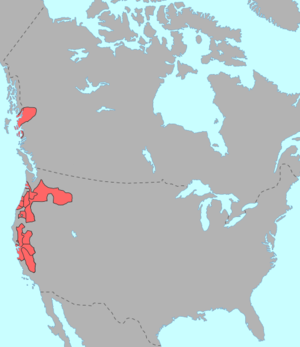Penutian
| Penutian | |
|---|---|
| (controversial) | |
| Geographic distribution |
North America |
| Linguistic classification | Proposed language family |
| Subdivisions | |
| Glottolog | None |

Distribution of proposed Penutian languages.
|
|
 |
|
Penutian is a proposed grouping of language families that includes many Native American languages of western North America, predominantly spoken at one time in Washington, Oregon, and California. The existence of a Penutian stock or phylum has been the subject of debate among specialists. Even the unity of some of its component families has been disputed. Some of the problems in the comparative study of languages within the phylum are the result of their early extinction and minimal documentation.
Consensus was reached at a 1994 workshop on Comparative Penutian at the University of Oregon that the families within the proposed phylum's California, Oregon, Plateau, and Chinookan clusters would eventually be shown to be genetically related. Subsequently, Marie-Lucie Tarpent reassessed Tsimshianic, a geographically isolated family in northern British Columbia, and concluded that its affiliation within Penutian is also probable.
Some of the more recently proposed subgroupings of Penutian have been convincingly demonstrated. The Miwokan and the Costanoan languages have been grouped into an Utian language family by Catherine Callaghan. Callaghan has more recently provided evidence supporting a grouping of Utian and Yokutsan into a Yok-Utian family. There also seems to be convincing evidence for the Plateau Penutian grouping (originally named Shahapwailutan by J. N. B. Hewitt and John Wesley Powell in 1894) which would consist of Klamath–Modoc, Molala, and the Sahaptian languages (Nez Percé and Sahaptin).
...
Wikipedia
